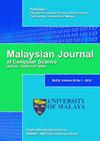HYBRID DISCRETE WAVELET TRANSFORM AND TEXTURE ANALYSIS METHODS FOR FEATURE EXTRACTION AND CLASSIFICATION OF BREAST DYNAMIC THERMOGRAM SEQUENCES
IF 1.2
4区 计算机科学
Q4 COMPUTER SCIENCE, ARTIFICIAL INTELLIGENCE
引用次数: 0
Abstract
Breast cancer is a common cancer that hits women causing thousands of casualties every year. A cancerous tumor causes an increase of temperature near the region of the tumor. The heat generated by the temperature transferred to the skin surface. The temperature in the tumor area is warmer than in the healthy area. Detecting breast cancer in early stages can save women’s lives and lower the burden on the cost. Thermography is an imaging technique used for breast cancer detection. A dynamic thermography technique which is used to generate infrared images over a fixed time measured in minutes to detect the difference between the normal and cancerous areas in images. In this research, we propose a methodology to deal with the changes of temperature in patient's breasts by defining a set of efficient features resulted from extraction and reduction of coefficients obtained from breast thermogram images followed by classification. Texture feature methods (Histogram of Oriented Gradients (HOG) and Discrete Curvelet transform) are applied separately using the HH (high-high) and HL (high-low) sub band images of Discrete Wavelet transform (DWT). HOG-based features and Curvelet features are extracted by reducing coefficients’ vectors returned by the two methods. Finally, Support Vector Machine (SVM) binary classifier is used to classify the images to either normal or abnormal. The proposed work has successfully achieved an Accuracy of 98.2%, Sensitivity of 97.7%, and Specificity of 98.2% through empirical studies using dynamic breast thermogram dataset.离散小波变换与纹理分析相结合的乳腺动态热图序列特征提取与分类方法
癌症是一种常见的癌症,每年侵袭女性,造成数千人死亡。癌性肿瘤导致肿瘤区域附近的温度升高。温度产生的热量传递到皮肤表面。肿瘤区域的温度比健康区域的温度高。早期发现癌症可以挽救妇女的生命,降低成本负担。热成像是一种用于检测癌症的成像技术。一种动态热成像技术,用于在以分钟为单位的固定时间内生成红外图像,以检测图像中正常区域和癌性区域之间的差异。在这项研究中,我们提出了一种方法来处理患者乳房温度的变化,方法是定义一组有效的特征,这些特征是从乳房体温图图像中提取和减少系数后进行分类的结果。使用离散小波变换(DWT)的HH(高-高)和HL(高-低)子带图像,分别应用纹理特征方法(定向梯度直方图(HOG)和离散Curvelet变换)。通过减少两种方法返回的系数向量,提取了基于HOG的特征和Curvelet特征。最后,使用支持向量机(SVM)二值分类器对图像进行正常或异常分类。通过使用动态乳房体温图数据集的实证研究,所提出的工作成功地实现了98.2%的准确度、97.7%的灵敏度和98.2%的特异性。
本文章由计算机程序翻译,如有差异,请以英文原文为准。
求助全文
约1分钟内获得全文
求助全文
来源期刊

Malaysian Journal of Computer Science
COMPUTER SCIENCE, ARTIFICIAL INTELLIGENCE-COMPUTER SCIENCE, THEORY & METHODS
CiteScore
2.20
自引率
33.30%
发文量
35
审稿时长
7.5 months
期刊介绍:
The Malaysian Journal of Computer Science (ISSN 0127-9084) is published four times a year in January, April, July and October by the Faculty of Computer Science and Information Technology, University of Malaya, since 1985. Over the years, the journal has gained popularity and the number of paper submissions has increased steadily. The rigorous reviews from the referees have helped in ensuring that the high standard of the journal is maintained. The objectives are to promote exchange of information and knowledge in research work, new inventions/developments of Computer Science and on the use of Information Technology towards the structuring of an information-rich society and to assist the academic staff from local and foreign universities, business and industrial sectors, government departments and academic institutions on publishing research results and studies in Computer Science and Information Technology through a scholarly publication. The journal is being indexed and abstracted by Clarivate Analytics'' Web of Science and Elsevier''s Scopus
 求助内容:
求助内容: 应助结果提醒方式:
应助结果提醒方式:


